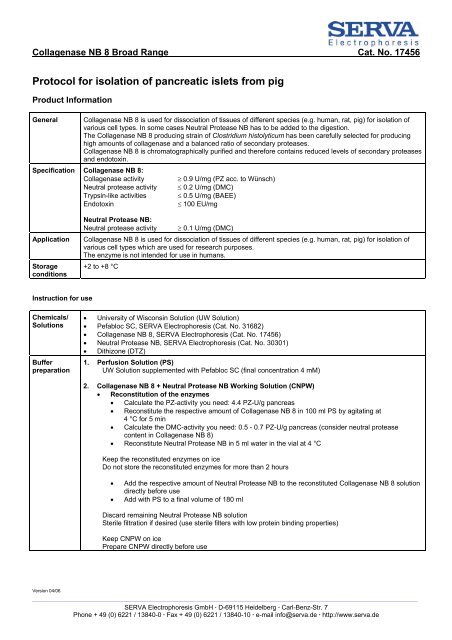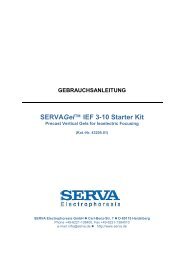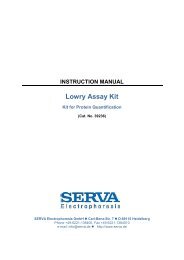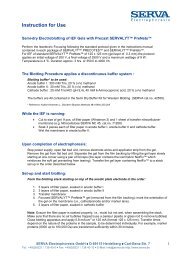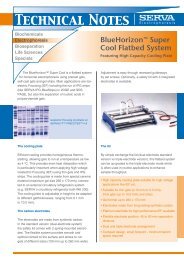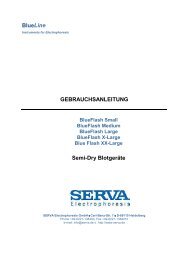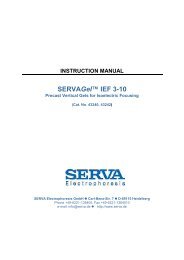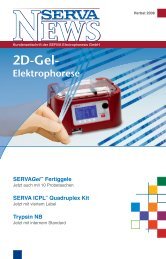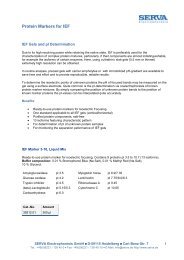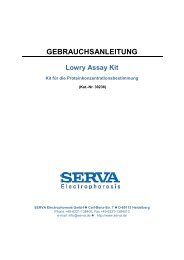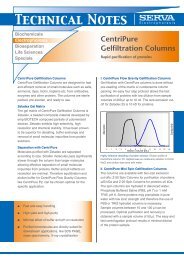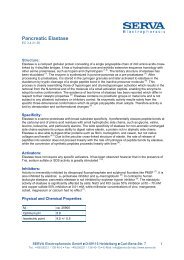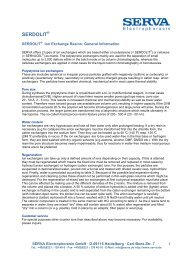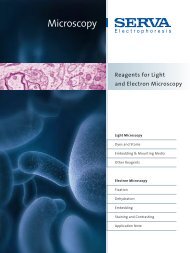Protoco for isolation of pancreatic islets from pig using Collagenase ...
Protoco for isolation of pancreatic islets from pig using Collagenase ...
Protoco for isolation of pancreatic islets from pig using Collagenase ...
You also want an ePaper? Increase the reach of your titles
YUMPU automatically turns print PDFs into web optimized ePapers that Google loves.
<strong>Collagenase</strong> NB 8 Broad Range Cat. No. 17456<br />
<strong>Protoco</strong>l <strong>for</strong> <strong>isolation</strong> <strong>of</strong> <strong>pancreatic</strong> <strong>islets</strong> <strong>from</strong> <strong>pig</strong><br />
Product In<strong>for</strong>mation<br />
General <strong>Collagenase</strong> NB 8 is used <strong>for</strong> dissociation <strong>of</strong> tissues <strong>of</strong> different species (e.g. human, rat, <strong>pig</strong>) <strong>for</strong> <strong>isolation</strong> <strong>of</strong><br />
various cell types. In some cases Neutral Protease NB has to be added to the digestion.<br />
The <strong>Collagenase</strong> NB 8 producing strain <strong>of</strong> Clostridium histolyticum has been carefully selected <strong>for</strong> producing<br />
high amounts <strong>of</strong> collagenase and a balanced ratio <strong>of</strong> secondary proteases.<br />
<strong>Collagenase</strong> NB 8 is chromatographically purified and there<strong>for</strong>e contains reduced levels <strong>of</strong> secondary proteases<br />
and endotoxin.<br />
Specification <strong>Collagenase</strong> NB 8:<br />
<strong>Collagenase</strong> activity ≥ 0.9 U/mg (PZ acc. to Wünsch)<br />
Neutral protease activity ≤ 0.2 U/mg (DMC)<br />
Trypsin-like activities ≤ 0.5 U/mg (BAEE)<br />
Endotoxin ≤ 100 EU/mg<br />
Version 04/06<br />
Neutral Protease NB:<br />
Neutral protease activity ≥ 0.1 U/mg (DMC)<br />
Application <strong>Collagenase</strong> NB 8 is used <strong>for</strong> dissociation <strong>of</strong> tissues <strong>of</strong> different species (e.g. human, rat, <strong>pig</strong>) <strong>for</strong> <strong>isolation</strong> <strong>of</strong><br />
various cell types which are used <strong>for</strong> research purposes.<br />
The enzyme is not intended <strong>for</strong> use in humans.<br />
Storage<br />
conditions<br />
Instruction <strong>for</strong> use<br />
Chemicals/<br />
Solutions<br />
Buffer<br />
preparation<br />
+2 to +8 °C<br />
• University <strong>of</strong> Wisconsin Solution (UW Solution)<br />
• Pefabloc SC, SERVA Electrophoresis (Cat. No. 31682)<br />
• <strong>Collagenase</strong> NB 8, SERVA Electrophoresis (Cat. No. 17456)<br />
• Neutral Protease NB, SERVA Electrophoresis (Cat. No. 30301)<br />
• Dithizone (DTZ)<br />
1. Perfusion Solution (PS)<br />
UW Solution supplemented with Pefabloc SC (final concentration 4 mM)<br />
2. <strong>Collagenase</strong> NB 8 + Neutral Protease NB Working Solution (CNPW)<br />
• Reconstitution <strong>of</strong> the enzymes<br />
• Calculate the PZ-activity you need: 4.4 PZ-U/g pancreas<br />
• Reconstitute the respective amount <strong>of</strong> <strong>Collagenase</strong> NB 8 in 100 ml PS by agitating at<br />
4 °C <strong>for</strong> 5 min<br />
• Calculate the DMC-activity you need: 0.5 - 0.7 PZ-U/g pancreas (consider neutral protease<br />
content in <strong>Collagenase</strong> NB 8)<br />
• Reconstitute Neutral Protease NB in 5 ml water in the vial at 4 °C<br />
Keep the reconstituted enzymes on ice<br />
Do not store the reconstituted enzymes <strong>for</strong> more than 2 hours<br />
• Add the respective amount <strong>of</strong> Neutral Protease NB to the reconstituted <strong>Collagenase</strong> NB 8 solution<br />
directly be<strong>for</strong>e use<br />
• Add with PS to a final volume <strong>of</strong> 180 ml<br />
Discard remaining Neutral Protease NB solution<br />
Sterile filtration if desired (use sterile filters with low protein binding properties)<br />
Keep CNPW on ice<br />
Prepare CNPW directly be<strong>for</strong>e use<br />
____________________________________________________________________________________________________________________________________________________________________________________________________________________________________<br />
SERVA Electrophoresis GmbH · D-69115 Heidelberg · Carl-Benz-Str. 7<br />
Phone + 49 (0) 6221 / 13840-0 · Fax + 49 (0) 6221 / 13840-10 · e-mail info@serva.de · http://www.serva.de
Pancreas<br />
dissection<br />
Pancreas<br />
dissociation<br />
1. Put pancreas on a tray which is cooled on ice<br />
2. Remove fat and membranes <strong>from</strong> the surface <strong>of</strong> the pancreas<br />
3. Cannulate the <strong>pancreatic</strong> duct, insert cannula as far as possible into the head <strong>of</strong> the pancreas<br />
4. Close secondary duct <strong>of</strong> the pancreas<br />
5. Perfuse the pancreas:<br />
Distend manually with the whole volume <strong>of</strong> cold CNPW <strong>using</strong> a syringe<br />
1. Cut the perfused pancreas into several pieces<br />
2. Prewarm PS at 37 °C<br />
3. Place perfused pancreas pieces and CNPW into the Ricordi chamber on top <strong>of</strong> the marbles<br />
4. Fill up the system with prewarmed PS<br />
5. Place mesh on top <strong>of</strong> the chamber to avoid blockage<br />
6. Reassemble chamber<br />
7. Circulate the solution with pump through chamber<br />
8. Adjust temperature to 37 °C as fast as possible<br />
9. Start shaking manually or automatically<br />
10. Monitor pH course (pH should not drop below 7.1)<br />
11. Aspire 2 - 3 ml samples every three to four minutes, stain with 1 – 2 ml Dithizone and monitor<br />
dissociation under a microscope<br />
12. When about 50 % free <strong>islets</strong> appear stop dissociation by dilution with cold PS and incubate <strong>for</strong><br />
approx. 10 min<br />
13. Open the chamber and remove the residual large tissue fragments <strong>using</strong> a mesh<br />
14. Rinse with cold solution<br />
15. Fill the cell suspension into centrifugation tubes<br />
16. Centrifuge at 500 x g<br />
17. Discard the supernatant<br />
18. Wash the pellets with cold PS<br />
19. Proceed with purification


